A Comprehensive Analysis of Simon Sinek's Public Performance
VerifiedAdded on 2023/06/11
|16
|5267
|345
Essay
AI Summary
This essay provides a comprehensive analysis of Simon Sinek's speech "How Great Leaders Inspire Actions," focusing on his use of rhetoric, persuasion, and the rhetorical triangle. It examines Sinek's central argument that belief is a primary driver of action, contrasting the Wright Brothers' success with Samuel Pierpont Langley's failure, despite Langley's superior resources. The analysis considers the speech's rhetorical background, foreground, and intended audience, which includes managers, leaders, and Ted Talks viewers. The essay further delves into the rhetorical triangle, exploring how Sinek employs ethos, pathos, and logos to build credibility, evoke emotion, and present logical arguments. Ultimately, the essay highlights Sinek's effective communication techniques and their impact on inspiring action through belief.
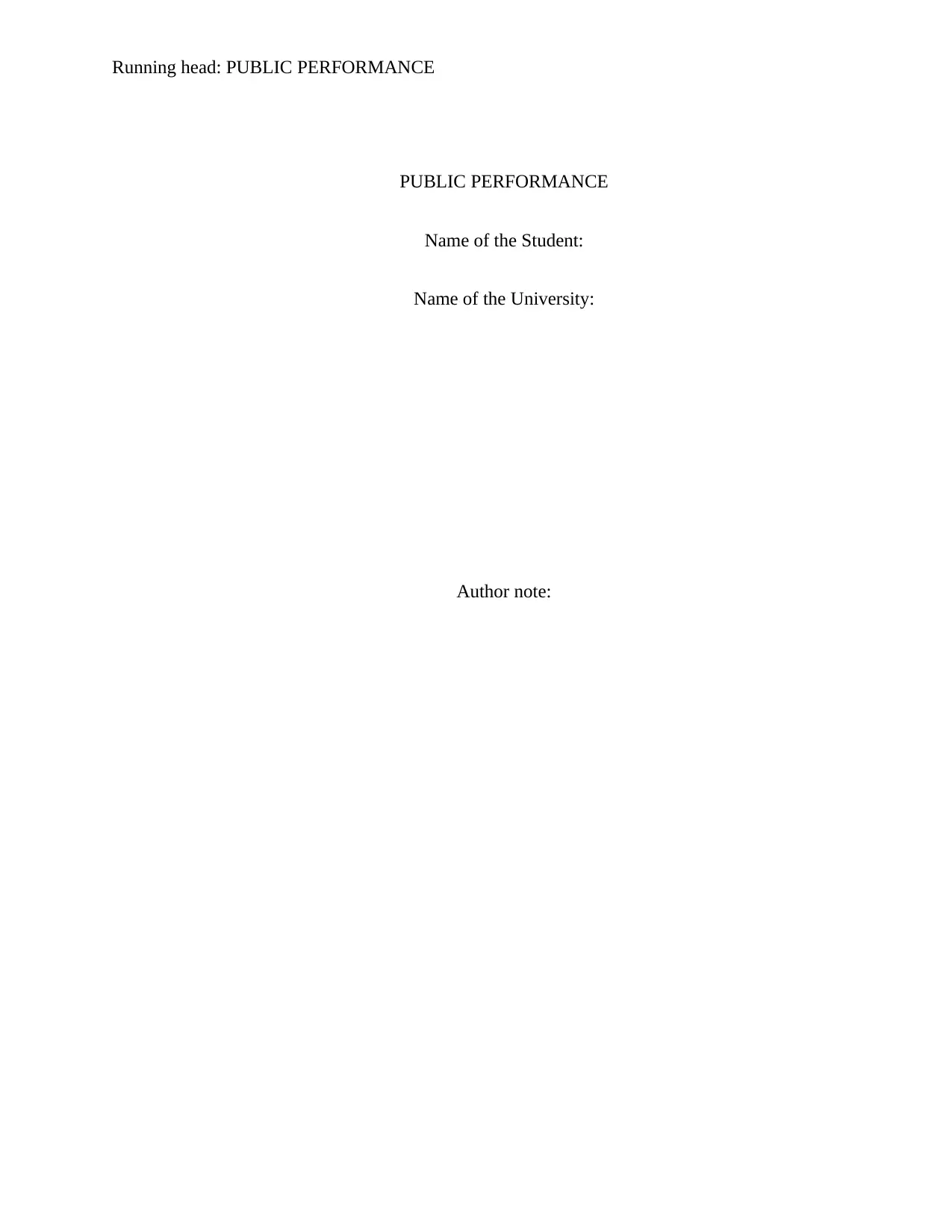
Running head: PUBLIC PERFORMANCE
PUBLIC PERFORMANCE
Name of the Student:
Name of the University:
Author note:
PUBLIC PERFORMANCE
Name of the Student:
Name of the University:
Author note:
Paraphrase This Document
Need a fresh take? Get an instant paraphrase of this document with our AI Paraphraser
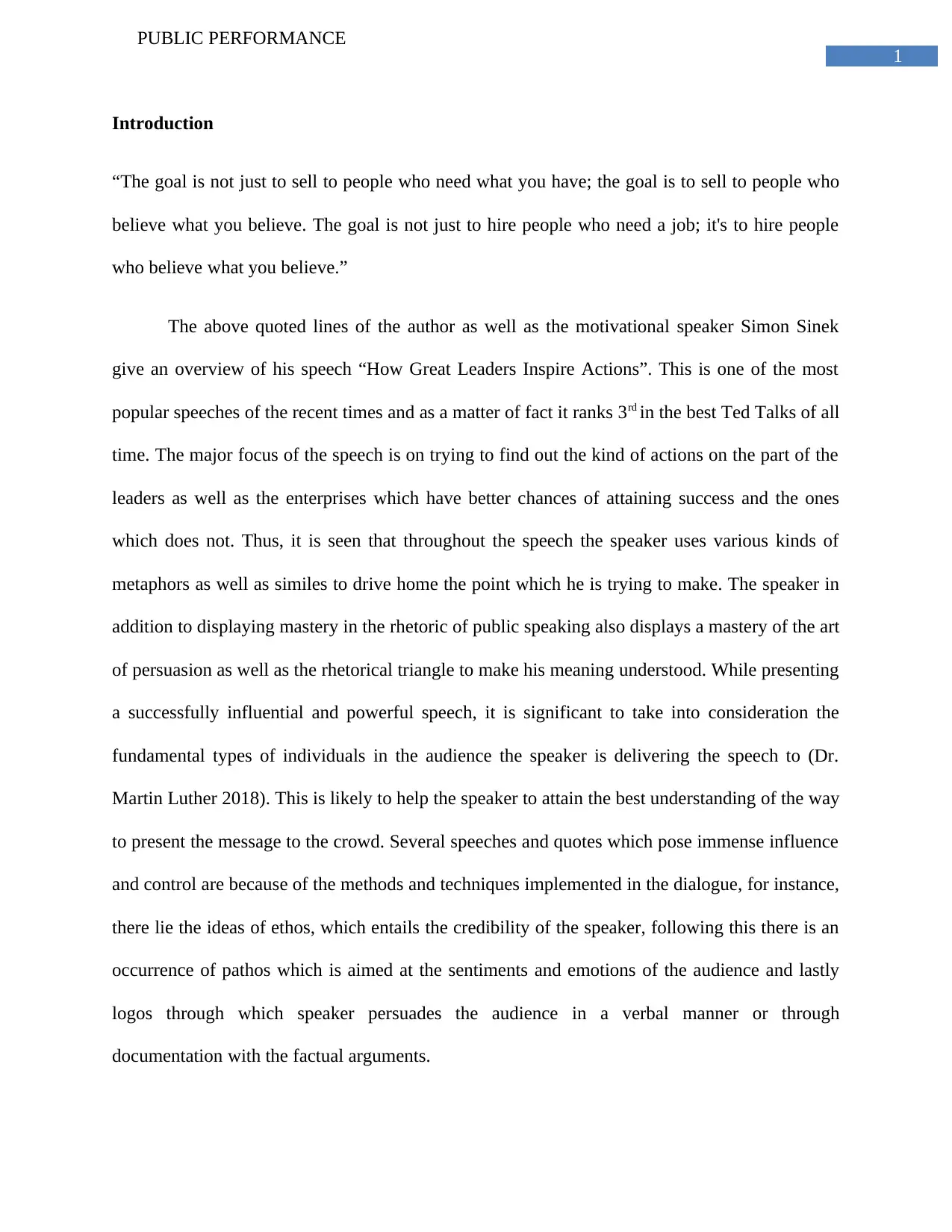
1
PUBLIC PERFORMANCE
Introduction
“The goal is not just to sell to people who need what you have; the goal is to sell to people who
believe what you believe. The goal is not just to hire people who need a job; it's to hire people
who believe what you believe.”
The above quoted lines of the author as well as the motivational speaker Simon Sinek
give an overview of his speech “How Great Leaders Inspire Actions”. This is one of the most
popular speeches of the recent times and as a matter of fact it ranks 3rd in the best Ted Talks of all
time. The major focus of the speech is on trying to find out the kind of actions on the part of the
leaders as well as the enterprises which have better chances of attaining success and the ones
which does not. Thus, it is seen that throughout the speech the speaker uses various kinds of
metaphors as well as similes to drive home the point which he is trying to make. The speaker in
addition to displaying mastery in the rhetoric of public speaking also displays a mastery of the art
of persuasion as well as the rhetorical triangle to make his meaning understood. While presenting
a successfully influential and powerful speech, it is significant to take into consideration the
fundamental types of individuals in the audience the speaker is delivering the speech to (Dr.
Martin Luther 2018). This is likely to help the speaker to attain the best understanding of the way
to present the message to the crowd. Several speeches and quotes which pose immense influence
and control are because of the methods and techniques implemented in the dialogue, for instance,
there lie the ideas of ethos, which entails the credibility of the speaker, following this there is an
occurrence of pathos which is aimed at the sentiments and emotions of the audience and lastly
logos through which speaker persuades the audience in a verbal manner or through
documentation with the factual arguments.
PUBLIC PERFORMANCE
Introduction
“The goal is not just to sell to people who need what you have; the goal is to sell to people who
believe what you believe. The goal is not just to hire people who need a job; it's to hire people
who believe what you believe.”
The above quoted lines of the author as well as the motivational speaker Simon Sinek
give an overview of his speech “How Great Leaders Inspire Actions”. This is one of the most
popular speeches of the recent times and as a matter of fact it ranks 3rd in the best Ted Talks of all
time. The major focus of the speech is on trying to find out the kind of actions on the part of the
leaders as well as the enterprises which have better chances of attaining success and the ones
which does not. Thus, it is seen that throughout the speech the speaker uses various kinds of
metaphors as well as similes to drive home the point which he is trying to make. The speaker in
addition to displaying mastery in the rhetoric of public speaking also displays a mastery of the art
of persuasion as well as the rhetorical triangle to make his meaning understood. While presenting
a successfully influential and powerful speech, it is significant to take into consideration the
fundamental types of individuals in the audience the speaker is delivering the speech to (Dr.
Martin Luther 2018). This is likely to help the speaker to attain the best understanding of the way
to present the message to the crowd. Several speeches and quotes which pose immense influence
and control are because of the methods and techniques implemented in the dialogue, for instance,
there lie the ideas of ethos, which entails the credibility of the speaker, following this there is an
occurrence of pathos which is aimed at the sentiments and emotions of the audience and lastly
logos through which speaker persuades the audience in a verbal manner or through
documentation with the factual arguments.
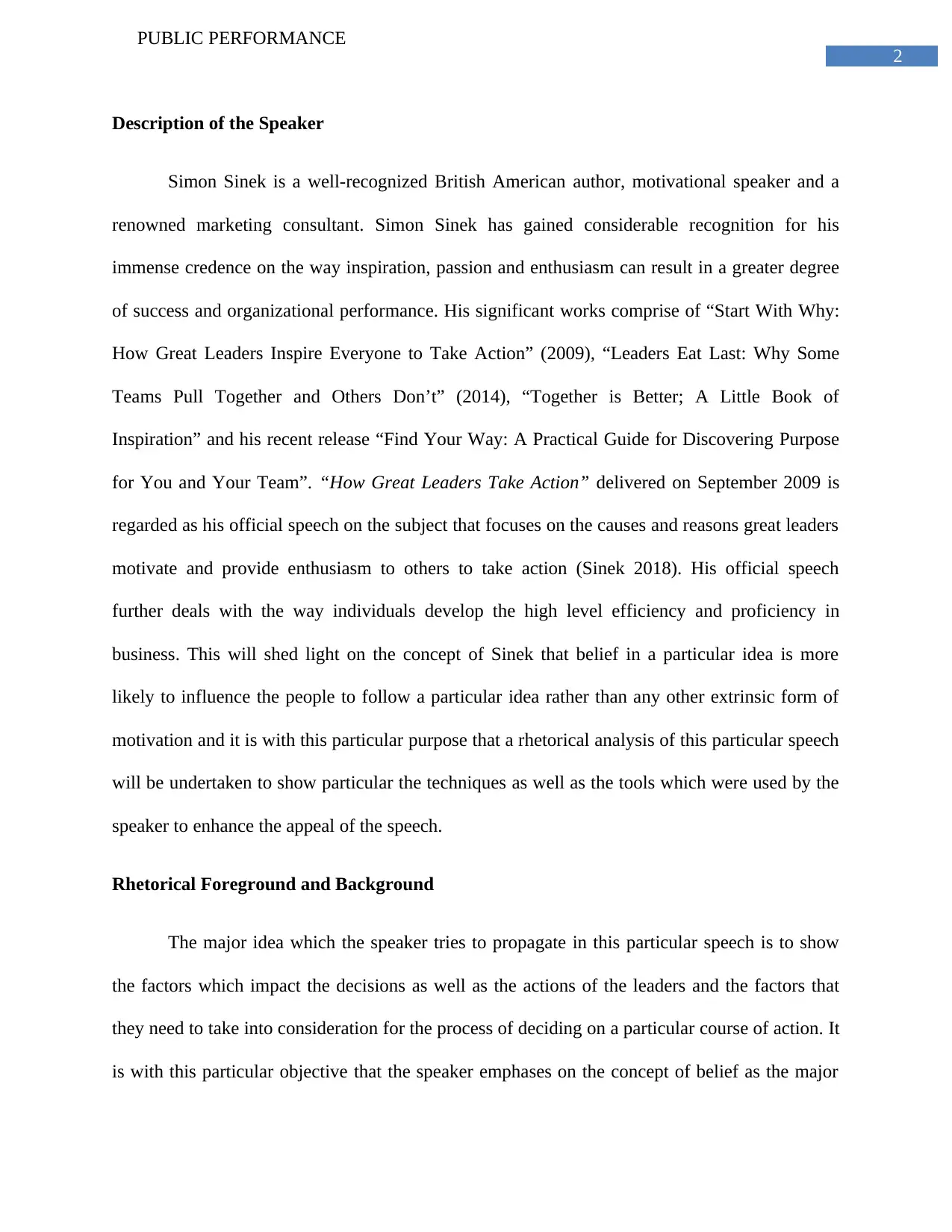
2
PUBLIC PERFORMANCE
Description of the Speaker
Simon Sinek is a well-recognized British American author, motivational speaker and a
renowned marketing consultant. Simon Sinek has gained considerable recognition for his
immense credence on the way inspiration, passion and enthusiasm can result in a greater degree
of success and organizational performance. His significant works comprise of “Start With Why:
How Great Leaders Inspire Everyone to Take Action” (2009), “Leaders Eat Last: Why Some
Teams Pull Together and Others Don’t” (2014), “Together is Better; A Little Book of
Inspiration” and his recent release “Find Your Way: A Practical Guide for Discovering Purpose
for You and Your Team”. “How Great Leaders Take Action” delivered on September 2009 is
regarded as his official speech on the subject that focuses on the causes and reasons great leaders
motivate and provide enthusiasm to others to take action (Sinek 2018). His official speech
further deals with the way individuals develop the high level efficiency and proficiency in
business. This will shed light on the concept of Sinek that belief in a particular idea is more
likely to influence the people to follow a particular idea rather than any other extrinsic form of
motivation and it is with this particular purpose that a rhetorical analysis of this particular speech
will be undertaken to show particular the techniques as well as the tools which were used by the
speaker to enhance the appeal of the speech.
Rhetorical Foreground and Background
The major idea which the speaker tries to propagate in this particular speech is to show
the factors which impact the decisions as well as the actions of the leaders and the factors that
they need to take into consideration for the process of deciding on a particular course of action. It
is with this particular objective that the speaker emphases on the concept of belief as the major
PUBLIC PERFORMANCE
Description of the Speaker
Simon Sinek is a well-recognized British American author, motivational speaker and a
renowned marketing consultant. Simon Sinek has gained considerable recognition for his
immense credence on the way inspiration, passion and enthusiasm can result in a greater degree
of success and organizational performance. His significant works comprise of “Start With Why:
How Great Leaders Inspire Everyone to Take Action” (2009), “Leaders Eat Last: Why Some
Teams Pull Together and Others Don’t” (2014), “Together is Better; A Little Book of
Inspiration” and his recent release “Find Your Way: A Practical Guide for Discovering Purpose
for You and Your Team”. “How Great Leaders Take Action” delivered on September 2009 is
regarded as his official speech on the subject that focuses on the causes and reasons great leaders
motivate and provide enthusiasm to others to take action (Sinek 2018). His official speech
further deals with the way individuals develop the high level efficiency and proficiency in
business. This will shed light on the concept of Sinek that belief in a particular idea is more
likely to influence the people to follow a particular idea rather than any other extrinsic form of
motivation and it is with this particular purpose that a rhetorical analysis of this particular speech
will be undertaken to show particular the techniques as well as the tools which were used by the
speaker to enhance the appeal of the speech.
Rhetorical Foreground and Background
The major idea which the speaker tries to propagate in this particular speech is to show
the factors which impact the decisions as well as the actions of the leaders and the factors that
they need to take into consideration for the process of deciding on a particular course of action. It
is with this particular objective that the speaker emphases on the concept of belief as the major
⊘ This is a preview!⊘
Do you want full access?
Subscribe today to unlock all pages.

Trusted by 1+ million students worldwide
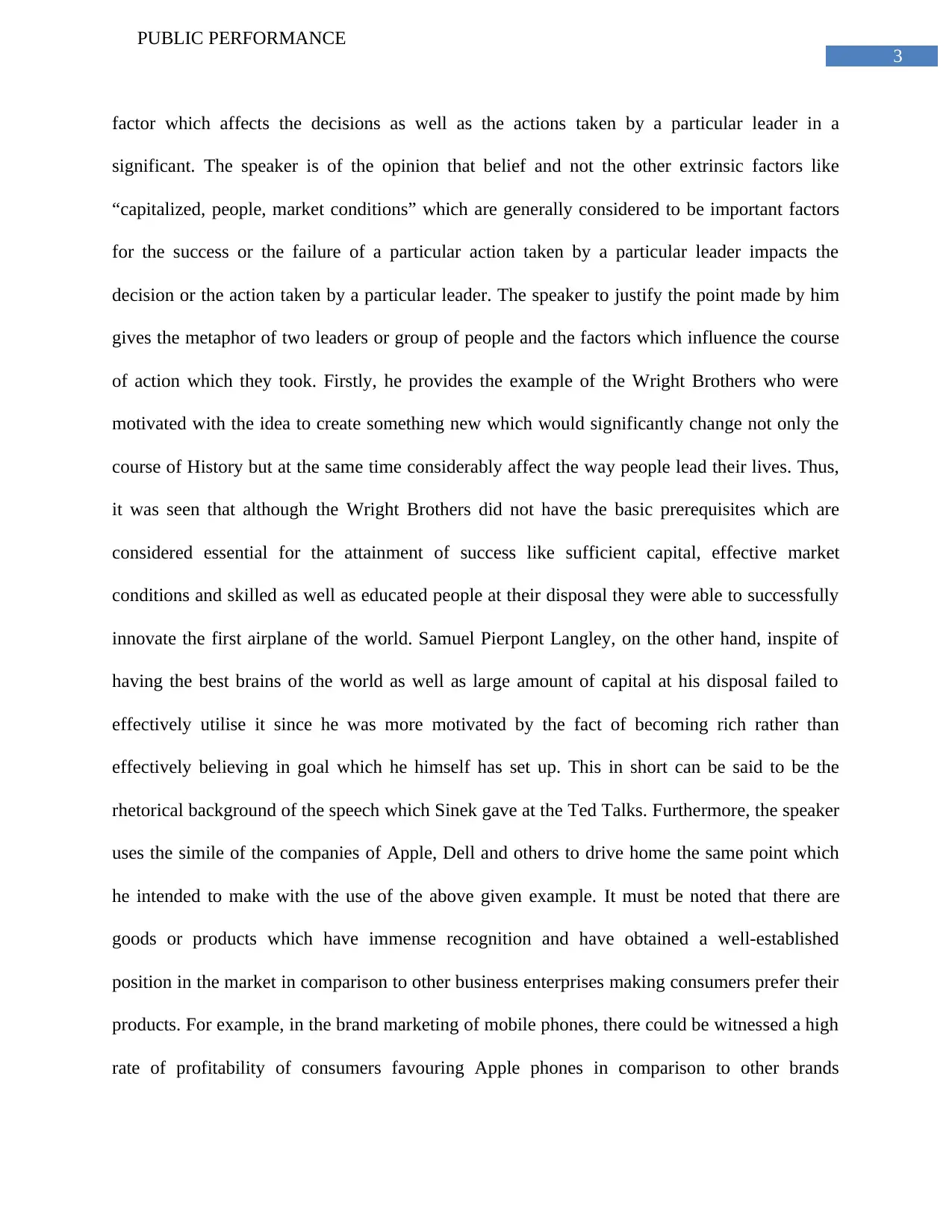
3
PUBLIC PERFORMANCE
factor which affects the decisions as well as the actions taken by a particular leader in a
significant. The speaker is of the opinion that belief and not the other extrinsic factors like
“capitalized, people, market conditions” which are generally considered to be important factors
for the success or the failure of a particular action taken by a particular leader impacts the
decision or the action taken by a particular leader. The speaker to justify the point made by him
gives the metaphor of two leaders or group of people and the factors which influence the course
of action which they took. Firstly, he provides the example of the Wright Brothers who were
motivated with the idea to create something new which would significantly change not only the
course of History but at the same time considerably affect the way people lead their lives. Thus,
it was seen that although the Wright Brothers did not have the basic prerequisites which are
considered essential for the attainment of success like sufficient capital, effective market
conditions and skilled as well as educated people at their disposal they were able to successfully
innovate the first airplane of the world. Samuel Pierpont Langley, on the other hand, inspite of
having the best brains of the world as well as large amount of capital at his disposal failed to
effectively utilise it since he was more motivated by the fact of becoming rich rather than
effectively believing in goal which he himself has set up. This in short can be said to be the
rhetorical background of the speech which Sinek gave at the Ted Talks. Furthermore, the speaker
uses the simile of the companies of Apple, Dell and others to drive home the same point which
he intended to make with the use of the above given example. It must be noted that there are
goods or products which have immense recognition and have obtained a well-established
position in the market in comparison to other business enterprises making consumers prefer their
products. For example, in the brand marketing of mobile phones, there could be witnessed a high
rate of profitability of consumers favouring Apple phones in comparison to other brands
PUBLIC PERFORMANCE
factor which affects the decisions as well as the actions taken by a particular leader in a
significant. The speaker is of the opinion that belief and not the other extrinsic factors like
“capitalized, people, market conditions” which are generally considered to be important factors
for the success or the failure of a particular action taken by a particular leader impacts the
decision or the action taken by a particular leader. The speaker to justify the point made by him
gives the metaphor of two leaders or group of people and the factors which influence the course
of action which they took. Firstly, he provides the example of the Wright Brothers who were
motivated with the idea to create something new which would significantly change not only the
course of History but at the same time considerably affect the way people lead their lives. Thus,
it was seen that although the Wright Brothers did not have the basic prerequisites which are
considered essential for the attainment of success like sufficient capital, effective market
conditions and skilled as well as educated people at their disposal they were able to successfully
innovate the first airplane of the world. Samuel Pierpont Langley, on the other hand, inspite of
having the best brains of the world as well as large amount of capital at his disposal failed to
effectively utilise it since he was more motivated by the fact of becoming rich rather than
effectively believing in goal which he himself has set up. This in short can be said to be the
rhetorical background of the speech which Sinek gave at the Ted Talks. Furthermore, the speaker
uses the simile of the companies of Apple, Dell and others to drive home the same point which
he intended to make with the use of the above given example. It must be noted that there are
goods or products which have immense recognition and have obtained a well-established
position in the market in comparison to other business enterprises making consumers prefer their
products. For example, in the brand marketing of mobile phones, there could be witnessed a high
rate of profitability of consumers favouring Apple phones in comparison to other brands
Paraphrase This Document
Need a fresh take? Get an instant paraphrase of this document with our AI Paraphraser
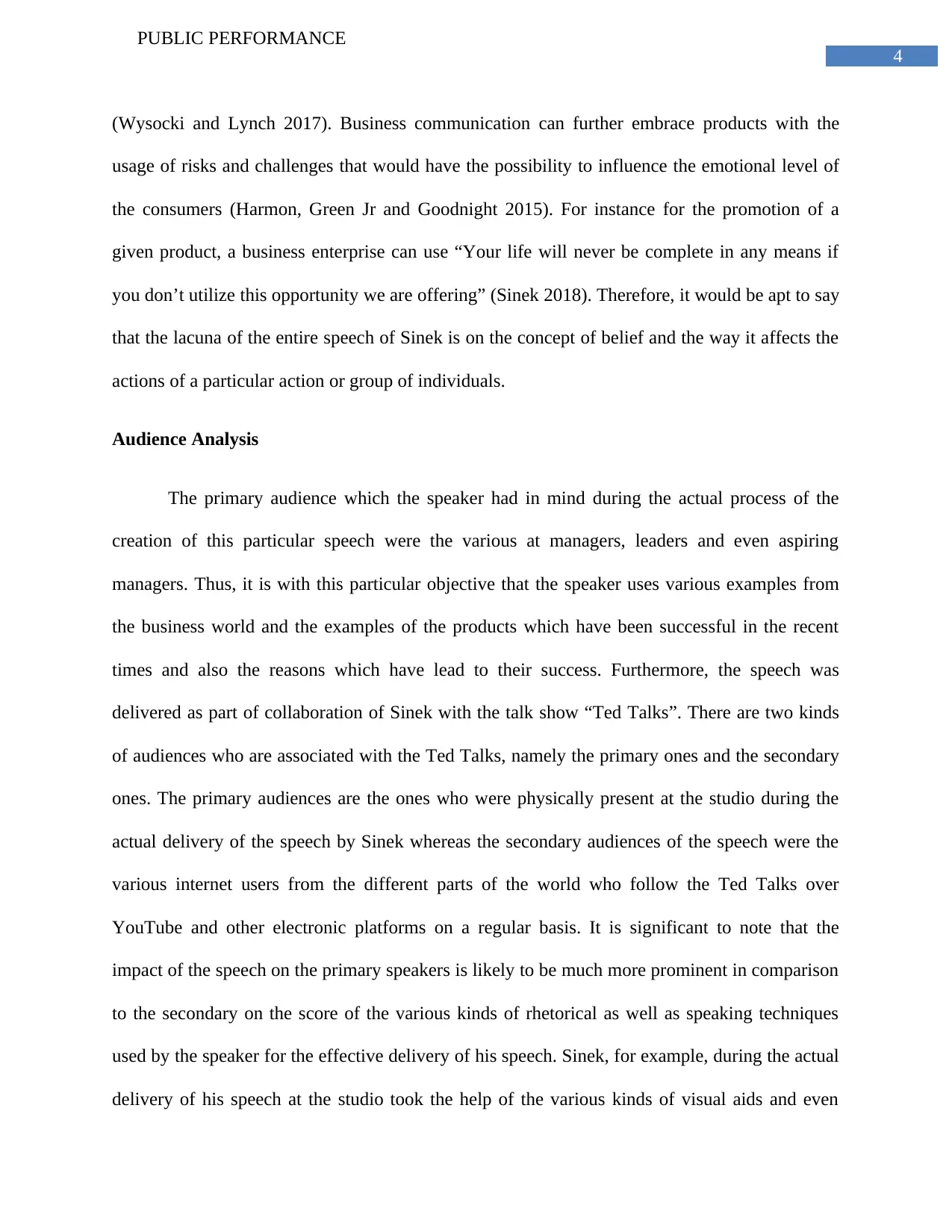
4
PUBLIC PERFORMANCE
(Wysocki and Lynch 2017). Business communication can further embrace products with the
usage of risks and challenges that would have the possibility to influence the emotional level of
the consumers (Harmon, Green Jr and Goodnight 2015). For instance for the promotion of a
given product, a business enterprise can use “Your life will never be complete in any means if
you don’t utilize this opportunity we are offering” (Sinek 2018). Therefore, it would be apt to say
that the lacuna of the entire speech of Sinek is on the concept of belief and the way it affects the
actions of a particular action or group of individuals.
Audience Analysis
The primary audience which the speaker had in mind during the actual process of the
creation of this particular speech were the various at managers, leaders and even aspiring
managers. Thus, it is with this particular objective that the speaker uses various examples from
the business world and the examples of the products which have been successful in the recent
times and also the reasons which have lead to their success. Furthermore, the speech was
delivered as part of collaboration of Sinek with the talk show “Ted Talks”. There are two kinds
of audiences who are associated with the Ted Talks, namely the primary ones and the secondary
ones. The primary audiences are the ones who were physically present at the studio during the
actual delivery of the speech by Sinek whereas the secondary audiences of the speech were the
various internet users from the different parts of the world who follow the Ted Talks over
YouTube and other electronic platforms on a regular basis. It is significant to note that the
impact of the speech on the primary speakers is likely to be much more prominent in comparison
to the secondary on the score of the various kinds of rhetorical as well as speaking techniques
used by the speaker for the effective delivery of his speech. Sinek, for example, during the actual
delivery of his speech at the studio took the help of the various kinds of visual aids and even
PUBLIC PERFORMANCE
(Wysocki and Lynch 2017). Business communication can further embrace products with the
usage of risks and challenges that would have the possibility to influence the emotional level of
the consumers (Harmon, Green Jr and Goodnight 2015). For instance for the promotion of a
given product, a business enterprise can use “Your life will never be complete in any means if
you don’t utilize this opportunity we are offering” (Sinek 2018). Therefore, it would be apt to say
that the lacuna of the entire speech of Sinek is on the concept of belief and the way it affects the
actions of a particular action or group of individuals.
Audience Analysis
The primary audience which the speaker had in mind during the actual process of the
creation of this particular speech were the various at managers, leaders and even aspiring
managers. Thus, it is with this particular objective that the speaker uses various examples from
the business world and the examples of the products which have been successful in the recent
times and also the reasons which have lead to their success. Furthermore, the speech was
delivered as part of collaboration of Sinek with the talk show “Ted Talks”. There are two kinds
of audiences who are associated with the Ted Talks, namely the primary ones and the secondary
ones. The primary audiences are the ones who were physically present at the studio during the
actual delivery of the speech by Sinek whereas the secondary audiences of the speech were the
various internet users from the different parts of the world who follow the Ted Talks over
YouTube and other electronic platforms on a regular basis. It is significant to note that the
impact of the speech on the primary speakers is likely to be much more prominent in comparison
to the secondary on the score of the various kinds of rhetorical as well as speaking techniques
used by the speaker for the effective delivery of his speech. Sinek, for example, during the actual
delivery of his speech at the studio took the help of the various kinds of visual aids and even
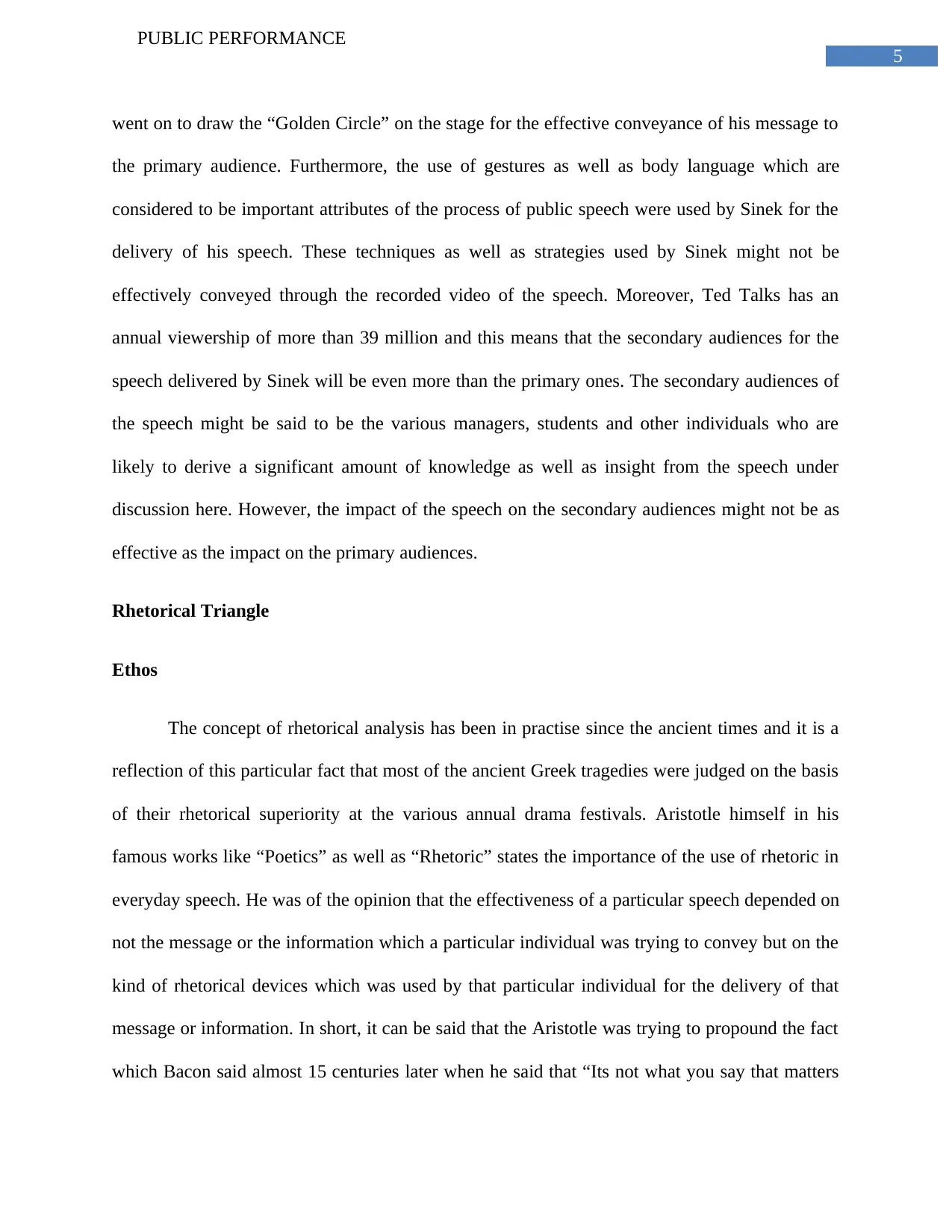
5
PUBLIC PERFORMANCE
went on to draw the “Golden Circle” on the stage for the effective conveyance of his message to
the primary audience. Furthermore, the use of gestures as well as body language which are
considered to be important attributes of the process of public speech were used by Sinek for the
delivery of his speech. These techniques as well as strategies used by Sinek might not be
effectively conveyed through the recorded video of the speech. Moreover, Ted Talks has an
annual viewership of more than 39 million and this means that the secondary audiences for the
speech delivered by Sinek will be even more than the primary ones. The secondary audiences of
the speech might be said to be the various managers, students and other individuals who are
likely to derive a significant amount of knowledge as well as insight from the speech under
discussion here. However, the impact of the speech on the secondary audiences might not be as
effective as the impact on the primary audiences.
Rhetorical Triangle
Ethos
The concept of rhetorical analysis has been in practise since the ancient times and it is a
reflection of this particular fact that most of the ancient Greek tragedies were judged on the basis
of their rhetorical superiority at the various annual drama festivals. Aristotle himself in his
famous works like “Poetics” as well as “Rhetoric” states the importance of the use of rhetoric in
everyday speech. He was of the opinion that the effectiveness of a particular speech depended on
not the message or the information which a particular individual was trying to convey but on the
kind of rhetorical devices which was used by that particular individual for the delivery of that
message or information. In short, it can be said that the Aristotle was trying to propound the fact
which Bacon said almost 15 centuries later when he said that “Its not what you say that matters
PUBLIC PERFORMANCE
went on to draw the “Golden Circle” on the stage for the effective conveyance of his message to
the primary audience. Furthermore, the use of gestures as well as body language which are
considered to be important attributes of the process of public speech were used by Sinek for the
delivery of his speech. These techniques as well as strategies used by Sinek might not be
effectively conveyed through the recorded video of the speech. Moreover, Ted Talks has an
annual viewership of more than 39 million and this means that the secondary audiences for the
speech delivered by Sinek will be even more than the primary ones. The secondary audiences of
the speech might be said to be the various managers, students and other individuals who are
likely to derive a significant amount of knowledge as well as insight from the speech under
discussion here. However, the impact of the speech on the secondary audiences might not be as
effective as the impact on the primary audiences.
Rhetorical Triangle
Ethos
The concept of rhetorical analysis has been in practise since the ancient times and it is a
reflection of this particular fact that most of the ancient Greek tragedies were judged on the basis
of their rhetorical superiority at the various annual drama festivals. Aristotle himself in his
famous works like “Poetics” as well as “Rhetoric” states the importance of the use of rhetoric in
everyday speech. He was of the opinion that the effectiveness of a particular speech depended on
not the message or the information which a particular individual was trying to convey but on the
kind of rhetorical devices which was used by that particular individual for the delivery of that
message or information. In short, it can be said that the Aristotle was trying to propound the fact
which Bacon said almost 15 centuries later when he said that “Its not what you say that matters
⊘ This is a preview!⊘
Do you want full access?
Subscribe today to unlock all pages.

Trusted by 1+ million students worldwide
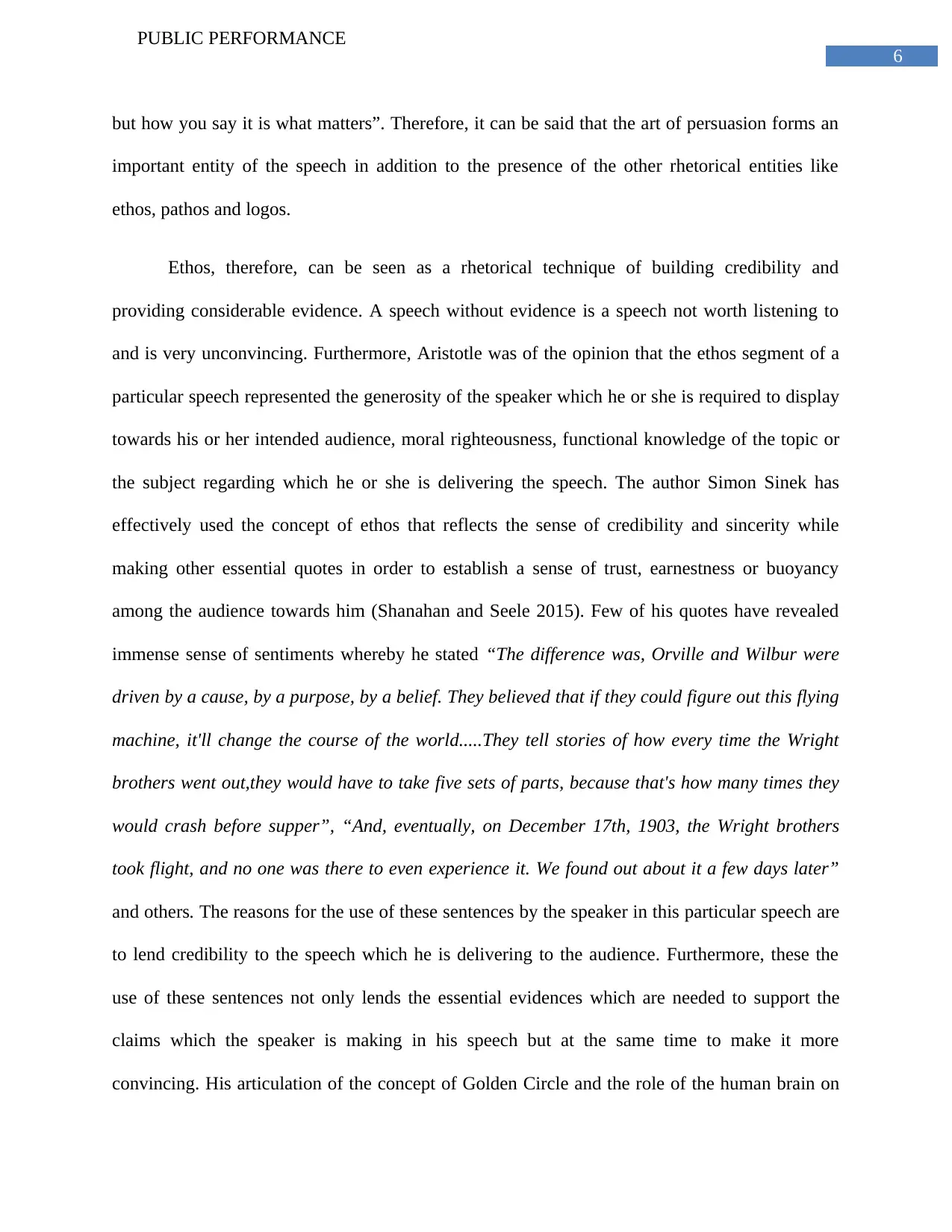
6
PUBLIC PERFORMANCE
but how you say it is what matters”. Therefore, it can be said that the art of persuasion forms an
important entity of the speech in addition to the presence of the other rhetorical entities like
ethos, pathos and logos.
Ethos, therefore, can be seen as a rhetorical technique of building credibility and
providing considerable evidence. A speech without evidence is a speech not worth listening to
and is very unconvincing. Furthermore, Aristotle was of the opinion that the ethos segment of a
particular speech represented the generosity of the speaker which he or she is required to display
towards his or her intended audience, moral righteousness, functional knowledge of the topic or
the subject regarding which he or she is delivering the speech. The author Simon Sinek has
effectively used the concept of ethos that reflects the sense of credibility and sincerity while
making other essential quotes in order to establish a sense of trust, earnestness or buoyancy
among the audience towards him (Shanahan and Seele 2015). Few of his quotes have revealed
immense sense of sentiments whereby he stated “The difference was, Orville and Wilbur were
driven by a cause, by a purpose, by a belief. They believed that if they could figure out this flying
machine, it'll change the course of the world.....They tell stories of how every time the Wright
brothers went out,they would have to take five sets of parts, because that's how many times they
would crash before supper”, “And, eventually, on December 17th, 1903, the Wright brothers
took flight, and no one was there to even experience it. We found out about it a few days later”
and others. The reasons for the use of these sentences by the speaker in this particular speech are
to lend credibility to the speech which he is delivering to the audience. Furthermore, these the
use of these sentences not only lends the essential evidences which are needed to support the
claims which the speaker is making in his speech but at the same time to make it more
convincing. His articulation of the concept of Golden Circle and the role of the human brain on
PUBLIC PERFORMANCE
but how you say it is what matters”. Therefore, it can be said that the art of persuasion forms an
important entity of the speech in addition to the presence of the other rhetorical entities like
ethos, pathos and logos.
Ethos, therefore, can be seen as a rhetorical technique of building credibility and
providing considerable evidence. A speech without evidence is a speech not worth listening to
and is very unconvincing. Furthermore, Aristotle was of the opinion that the ethos segment of a
particular speech represented the generosity of the speaker which he or she is required to display
towards his or her intended audience, moral righteousness, functional knowledge of the topic or
the subject regarding which he or she is delivering the speech. The author Simon Sinek has
effectively used the concept of ethos that reflects the sense of credibility and sincerity while
making other essential quotes in order to establish a sense of trust, earnestness or buoyancy
among the audience towards him (Shanahan and Seele 2015). Few of his quotes have revealed
immense sense of sentiments whereby he stated “The difference was, Orville and Wilbur were
driven by a cause, by a purpose, by a belief. They believed that if they could figure out this flying
machine, it'll change the course of the world.....They tell stories of how every time the Wright
brothers went out,they would have to take five sets of parts, because that's how many times they
would crash before supper”, “And, eventually, on December 17th, 1903, the Wright brothers
took flight, and no one was there to even experience it. We found out about it a few days later”
and others. The reasons for the use of these sentences by the speaker in this particular speech are
to lend credibility to the speech which he is delivering to the audience. Furthermore, these the
use of these sentences not only lends the essential evidences which are needed to support the
claims which the speaker is making in his speech but at the same time to make it more
convincing. His articulation of the concept of Golden Circle and the role of the human brain on
Paraphrase This Document
Need a fresh take? Get an instant paraphrase of this document with our AI Paraphraser
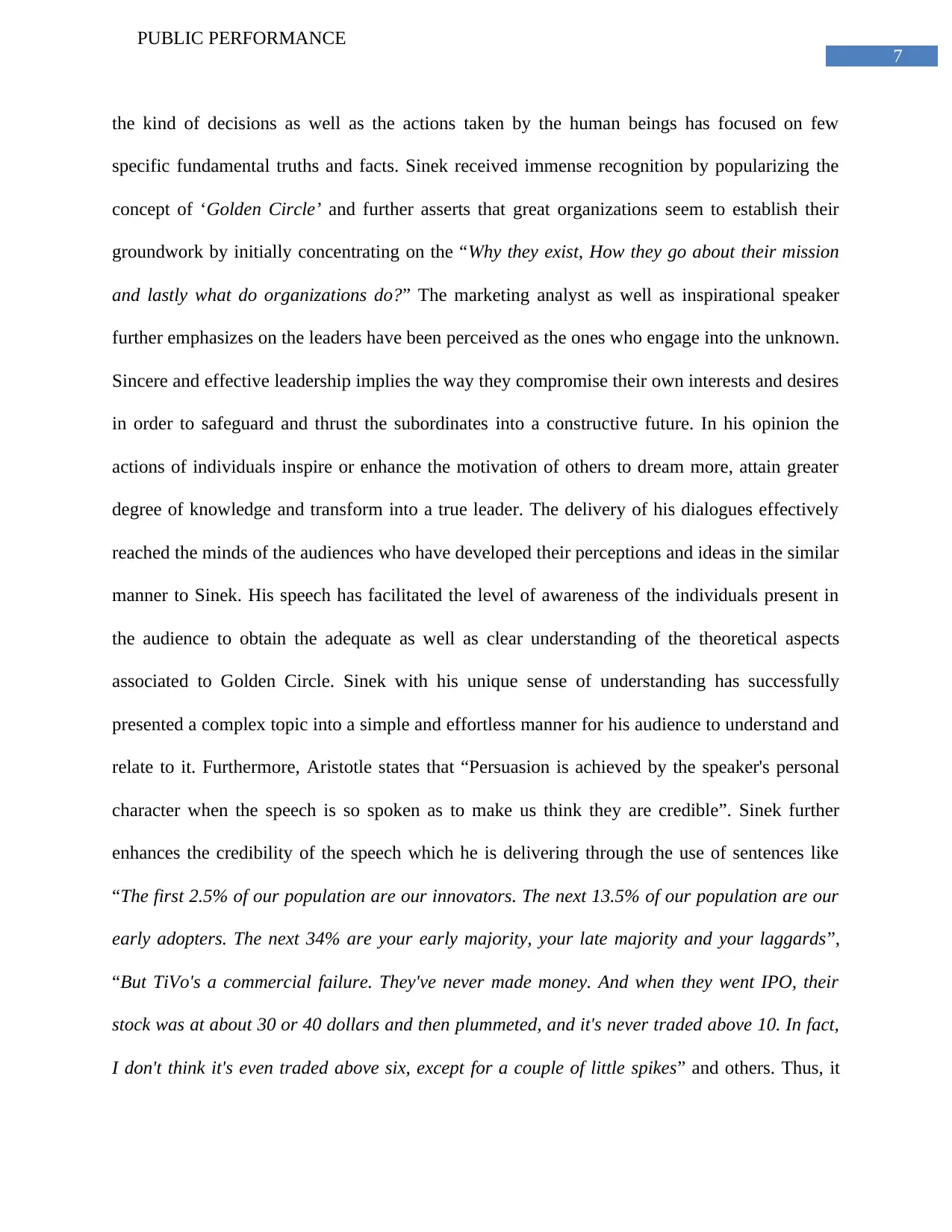
7
PUBLIC PERFORMANCE
the kind of decisions as well as the actions taken by the human beings has focused on few
specific fundamental truths and facts. Sinek received immense recognition by popularizing the
concept of ‘Golden Circle’ and further asserts that great organizations seem to establish their
groundwork by initially concentrating on the “Why they exist, How they go about their mission
and lastly what do organizations do?” The marketing analyst as well as inspirational speaker
further emphasizes on the leaders have been perceived as the ones who engage into the unknown.
Sincere and effective leadership implies the way they compromise their own interests and desires
in order to safeguard and thrust the subordinates into a constructive future. In his opinion the
actions of individuals inspire or enhance the motivation of others to dream more, attain greater
degree of knowledge and transform into a true leader. The delivery of his dialogues effectively
reached the minds of the audiences who have developed their perceptions and ideas in the similar
manner to Sinek. His speech has facilitated the level of awareness of the individuals present in
the audience to obtain the adequate as well as clear understanding of the theoretical aspects
associated to Golden Circle. Sinek with his unique sense of understanding has successfully
presented a complex topic into a simple and effortless manner for his audience to understand and
relate to it. Furthermore, Aristotle states that “Persuasion is achieved by the speaker's personal
character when the speech is so spoken as to make us think they are credible”. Sinek further
enhances the credibility of the speech which he is delivering through the use of sentences like
“The first 2.5% of our population are our innovators. The next 13.5% of our population are our
early adopters. The next 34% are your early majority, your late majority and your laggards”,
“But TiVo's a commercial failure. They've never made money. And when they went IPO, their
stock was at about 30 or 40 dollars and then plummeted, and it's never traded above 10. In fact,
I don't think it's even traded above six, except for a couple of little spikes” and others. Thus, it
PUBLIC PERFORMANCE
the kind of decisions as well as the actions taken by the human beings has focused on few
specific fundamental truths and facts. Sinek received immense recognition by popularizing the
concept of ‘Golden Circle’ and further asserts that great organizations seem to establish their
groundwork by initially concentrating on the “Why they exist, How they go about their mission
and lastly what do organizations do?” The marketing analyst as well as inspirational speaker
further emphasizes on the leaders have been perceived as the ones who engage into the unknown.
Sincere and effective leadership implies the way they compromise their own interests and desires
in order to safeguard and thrust the subordinates into a constructive future. In his opinion the
actions of individuals inspire or enhance the motivation of others to dream more, attain greater
degree of knowledge and transform into a true leader. The delivery of his dialogues effectively
reached the minds of the audiences who have developed their perceptions and ideas in the similar
manner to Sinek. His speech has facilitated the level of awareness of the individuals present in
the audience to obtain the adequate as well as clear understanding of the theoretical aspects
associated to Golden Circle. Sinek with his unique sense of understanding has successfully
presented a complex topic into a simple and effortless manner for his audience to understand and
relate to it. Furthermore, Aristotle states that “Persuasion is achieved by the speaker's personal
character when the speech is so spoken as to make us think they are credible”. Sinek further
enhances the credibility of the speech which he is delivering through the use of sentences like
“The first 2.5% of our population are our innovators. The next 13.5% of our population are our
early adopters. The next 34% are your early majority, your late majority and your laggards”,
“But TiVo's a commercial failure. They've never made money. And when they went IPO, their
stock was at about 30 or 40 dollars and then plummeted, and it's never traded above 10. In fact,
I don't think it's even traded above six, except for a couple of little spikes” and others. Thus, it
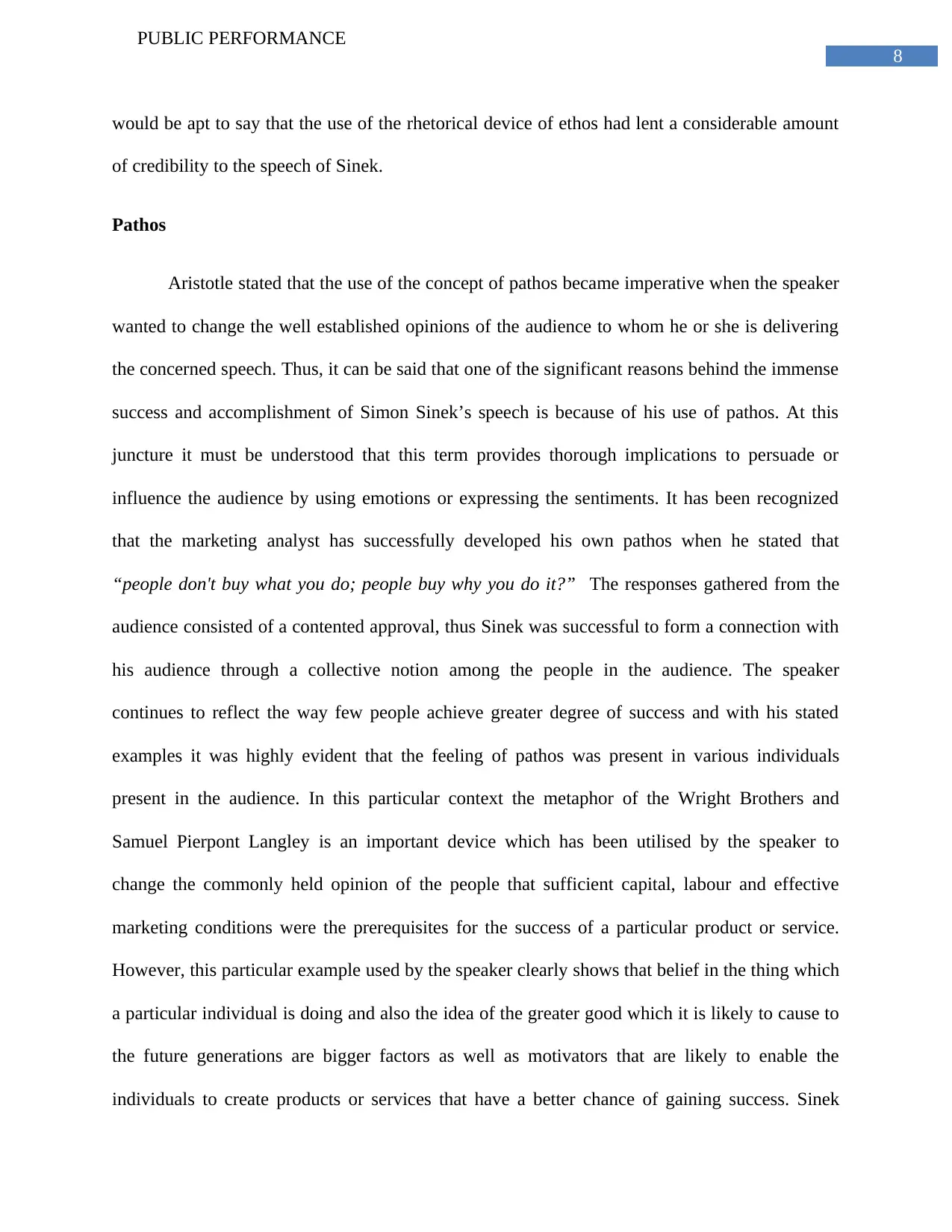
8
PUBLIC PERFORMANCE
would be apt to say that the use of the rhetorical device of ethos had lent a considerable amount
of credibility to the speech of Sinek.
Pathos
Aristotle stated that the use of the concept of pathos became imperative when the speaker
wanted to change the well established opinions of the audience to whom he or she is delivering
the concerned speech. Thus, it can be said that one of the significant reasons behind the immense
success and accomplishment of Simon Sinek’s speech is because of his use of pathos. At this
juncture it must be understood that this term provides thorough implications to persuade or
influence the audience by using emotions or expressing the sentiments. It has been recognized
that the marketing analyst has successfully developed his own pathos when he stated that
“people don't buy what you do; people buy why you do it?” The responses gathered from the
audience consisted of a contented approval, thus Sinek was successful to form a connection with
his audience through a collective notion among the people in the audience. The speaker
continues to reflect the way few people achieve greater degree of success and with his stated
examples it was highly evident that the feeling of pathos was present in various individuals
present in the audience. In this particular context the metaphor of the Wright Brothers and
Samuel Pierpont Langley is an important device which has been utilised by the speaker to
change the commonly held opinion of the people that sufficient capital, labour and effective
marketing conditions were the prerequisites for the success of a particular product or service.
However, this particular example used by the speaker clearly shows that belief in the thing which
a particular individual is doing and also the idea of the greater good which it is likely to cause to
the future generations are bigger factors as well as motivators that are likely to enable the
individuals to create products or services that have a better chance of gaining success. Sinek
PUBLIC PERFORMANCE
would be apt to say that the use of the rhetorical device of ethos had lent a considerable amount
of credibility to the speech of Sinek.
Pathos
Aristotle stated that the use of the concept of pathos became imperative when the speaker
wanted to change the well established opinions of the audience to whom he or she is delivering
the concerned speech. Thus, it can be said that one of the significant reasons behind the immense
success and accomplishment of Simon Sinek’s speech is because of his use of pathos. At this
juncture it must be understood that this term provides thorough implications to persuade or
influence the audience by using emotions or expressing the sentiments. It has been recognized
that the marketing analyst has successfully developed his own pathos when he stated that
“people don't buy what you do; people buy why you do it?” The responses gathered from the
audience consisted of a contented approval, thus Sinek was successful to form a connection with
his audience through a collective notion among the people in the audience. The speaker
continues to reflect the way few people achieve greater degree of success and with his stated
examples it was highly evident that the feeling of pathos was present in various individuals
present in the audience. In this particular context the metaphor of the Wright Brothers and
Samuel Pierpont Langley is an important device which has been utilised by the speaker to
change the commonly held opinion of the people that sufficient capital, labour and effective
marketing conditions were the prerequisites for the success of a particular product or service.
However, this particular example used by the speaker clearly shows that belief in the thing which
a particular individual is doing and also the idea of the greater good which it is likely to cause to
the future generations are bigger factors as well as motivators that are likely to enable the
individuals to create products or services that have a better chance of gaining success. Sinek
⊘ This is a preview!⊘
Do you want full access?
Subscribe today to unlock all pages.

Trusted by 1+ million students worldwide

9
PUBLIC PERFORMANCE
during the course of his speech has referred to Martin Luther King with the words that “people
who believed what he believed took his cause, and they made it their own, and they told people
and some of those people created structures to get the word out to even more people”.A sense of
pathos has been further established by Sinek when he puts the question to his audience “How do
you explain when things don't go as we assume? Or better, how do you explain when others are
able to achieve things that seem to defy all of the assumptions?” While establishing the
conversation with the audience, it has been witnessed by Sinek that the audience has gained a
sense of belongingness and respect as the speaker has been in direct interaction with them, which
has elevated the sense of adapted assurance and further increases the sense of unified
consideration. “Why is it that Dr. King led the civil rights movement? Why is it that the Wright
brothers were the ones that discovered, controlled and powered man’s flight when others were
more qualified and better funded?”is considered as a rhetorically structured question which has
appealed to note and sense of emotion in the minds of the audience (Dr. Martin Luther 2018). In
addition to these Sinek’s references to these individuals have critically created a sense of
commitment and anticipation to individuals of varied demographic backgrounds, in particular to
his audience who have gained adequate knowledge and understanding of the subjects Sinek has
been presenting. Simon has shown greater degree of efficacy when he blended his dialogues that
created higher degree of pathos when he argued “Now let me give you a successful example of
the law of diffusion of innovation. In the summer of 1963, 250,000 people showed up on the mall
in Washington to hear Dr. King speak. They sent out no invitations, and there was no website to
check the date. How do you do that? Well, Dr. King wasn’t the only man in America who was a
great orator. He wasn’t the only man in America who suffered in a pre-civil rights America. In
fact, some of his ideas were bad. But he had a gift. He didn’t go around telling people what
PUBLIC PERFORMANCE
during the course of his speech has referred to Martin Luther King with the words that “people
who believed what he believed took his cause, and they made it their own, and they told people
and some of those people created structures to get the word out to even more people”.A sense of
pathos has been further established by Sinek when he puts the question to his audience “How do
you explain when things don't go as we assume? Or better, how do you explain when others are
able to achieve things that seem to defy all of the assumptions?” While establishing the
conversation with the audience, it has been witnessed by Sinek that the audience has gained a
sense of belongingness and respect as the speaker has been in direct interaction with them, which
has elevated the sense of adapted assurance and further increases the sense of unified
consideration. “Why is it that Dr. King led the civil rights movement? Why is it that the Wright
brothers were the ones that discovered, controlled and powered man’s flight when others were
more qualified and better funded?”is considered as a rhetorically structured question which has
appealed to note and sense of emotion in the minds of the audience (Dr. Martin Luther 2018). In
addition to these Sinek’s references to these individuals have critically created a sense of
commitment and anticipation to individuals of varied demographic backgrounds, in particular to
his audience who have gained adequate knowledge and understanding of the subjects Sinek has
been presenting. Simon has shown greater degree of efficacy when he blended his dialogues that
created higher degree of pathos when he argued “Now let me give you a successful example of
the law of diffusion of innovation. In the summer of 1963, 250,000 people showed up on the mall
in Washington to hear Dr. King speak. They sent out no invitations, and there was no website to
check the date. How do you do that? Well, Dr. King wasn’t the only man in America who was a
great orator. He wasn’t the only man in America who suffered in a pre-civil rights America. In
fact, some of his ideas were bad. But he had a gift. He didn’t go around telling people what
Paraphrase This Document
Need a fresh take? Get an instant paraphrase of this document with our AI Paraphraser
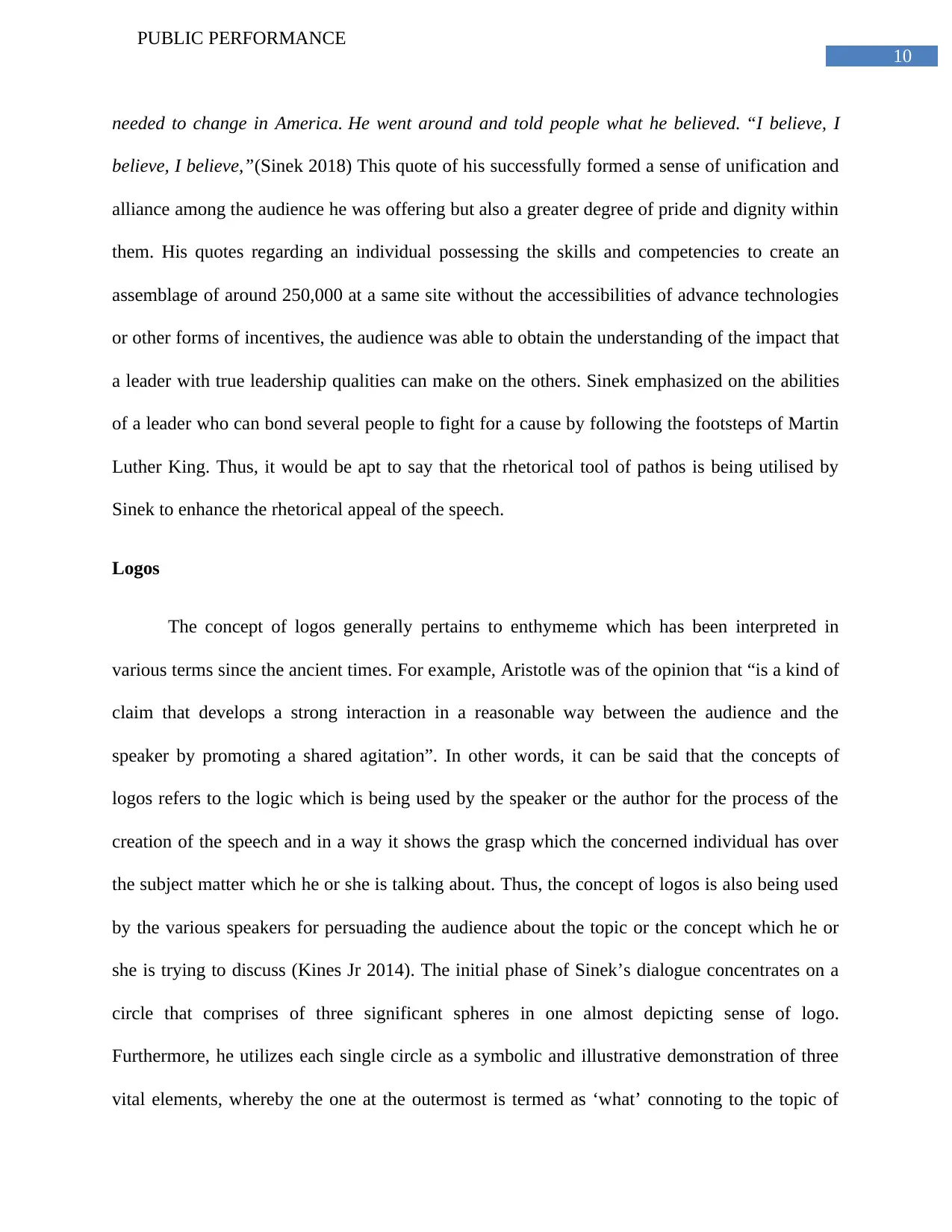
10
PUBLIC PERFORMANCE
needed to change in America. He went around and told people what he believed. “I believe, I
believe, I believe,”(Sinek 2018) This quote of his successfully formed a sense of unification and
alliance among the audience he was offering but also a greater degree of pride and dignity within
them. His quotes regarding an individual possessing the skills and competencies to create an
assemblage of around 250,000 at a same site without the accessibilities of advance technologies
or other forms of incentives, the audience was able to obtain the understanding of the impact that
a leader with true leadership qualities can make on the others. Sinek emphasized on the abilities
of a leader who can bond several people to fight for a cause by following the footsteps of Martin
Luther King. Thus, it would be apt to say that the rhetorical tool of pathos is being utilised by
Sinek to enhance the rhetorical appeal of the speech.
Logos
The concept of logos generally pertains to enthymeme which has been interpreted in
various terms since the ancient times. For example, Aristotle was of the opinion that “is a kind of
claim that develops a strong interaction in a reasonable way between the audience and the
speaker by promoting a shared agitation”. In other words, it can be said that the concepts of
logos refers to the logic which is being used by the speaker or the author for the process of the
creation of the speech and in a way it shows the grasp which the concerned individual has over
the subject matter which he or she is talking about. Thus, the concept of logos is also being used
by the various speakers for persuading the audience about the topic or the concept which he or
she is trying to discuss (Kines Jr 2014). The initial phase of Sinek’s dialogue concentrates on a
circle that comprises of three significant spheres in one almost depicting sense of logo.
Furthermore, he utilizes each single circle as a symbolic and illustrative demonstration of three
vital elements, whereby the one at the outermost is termed as ‘what’ connoting to the topic of
PUBLIC PERFORMANCE
needed to change in America. He went around and told people what he believed. “I believe, I
believe, I believe,”(Sinek 2018) This quote of his successfully formed a sense of unification and
alliance among the audience he was offering but also a greater degree of pride and dignity within
them. His quotes regarding an individual possessing the skills and competencies to create an
assemblage of around 250,000 at a same site without the accessibilities of advance technologies
or other forms of incentives, the audience was able to obtain the understanding of the impact that
a leader with true leadership qualities can make on the others. Sinek emphasized on the abilities
of a leader who can bond several people to fight for a cause by following the footsteps of Martin
Luther King. Thus, it would be apt to say that the rhetorical tool of pathos is being utilised by
Sinek to enhance the rhetorical appeal of the speech.
Logos
The concept of logos generally pertains to enthymeme which has been interpreted in
various terms since the ancient times. For example, Aristotle was of the opinion that “is a kind of
claim that develops a strong interaction in a reasonable way between the audience and the
speaker by promoting a shared agitation”. In other words, it can be said that the concepts of
logos refers to the logic which is being used by the speaker or the author for the process of the
creation of the speech and in a way it shows the grasp which the concerned individual has over
the subject matter which he or she is talking about. Thus, the concept of logos is also being used
by the various speakers for persuading the audience about the topic or the concept which he or
she is trying to discuss (Kines Jr 2014). The initial phase of Sinek’s dialogue concentrates on a
circle that comprises of three significant spheres in one almost depicting sense of logo.
Furthermore, he utilizes each single circle as a symbolic and illustrative demonstration of three
vital elements, whereby the one at the outermost is termed as ‘what’ connoting to the topic of

11
PUBLIC PERFORMANCE
discussion an individual has engaged in. Following it, the middle circle has been termed as ‘how’
that signifies the way the topic has been raised. However, the inner most circles related to the
question ‘why’ which depicts the reasons an individual would take the subject into consideration
or have a sense of belief on the ideas behind. It has been further claimed by Sinek, while
intending to reach to the minds of the audience, major section of speakers tends to travel from
the outer most circle and gradually pave their way towards the factors associated to the inner
circle, which has further been explained by Sinek by shedding light on the way renowned
organizations have introduced strategies for their product development by starting from the
centre circle (why) and further dealt with the other two factors related to ‘what’ and ‘how’.
Instances of the way Apple has been advertising their products can be regarded as a significant
concept as a whole. Furthermore, the utilization of logos has provided considerable rate of
contribution to the references which have been drawn by Sinek in the other quotes presented b y
him during this talk. One of the dialogues stated by Sinek “People don't buy what you do; they
buy why you do it. If you talk about what you believe, you will attract those who believe what you
believe.” clearly depicts his immense knowledge and awareness of the causes behind the concept
of marketing and the factors which affect the buying pattern of the customers in the present
times. Moreover by giving the example of the TiVo he intended to instil the knowledge of the
approaches TiVo has taken from the outer circumference of the circle by sharing their ideas
which would pause TV or the techniques would rewind it. However, the company was
incompetent to gather adequate customer confidence which had led them to choose the second
approach that started from the outermost rather than inclining towards the centre circle and
would have produced an increased rate of efficiency and productivity to the company by further
stating “If you're the kind of person who likes to have total control over every aspect of your life,
PUBLIC PERFORMANCE
discussion an individual has engaged in. Following it, the middle circle has been termed as ‘how’
that signifies the way the topic has been raised. However, the inner most circles related to the
question ‘why’ which depicts the reasons an individual would take the subject into consideration
or have a sense of belief on the ideas behind. It has been further claimed by Sinek, while
intending to reach to the minds of the audience, major section of speakers tends to travel from
the outer most circle and gradually pave their way towards the factors associated to the inner
circle, which has further been explained by Sinek by shedding light on the way renowned
organizations have introduced strategies for their product development by starting from the
centre circle (why) and further dealt with the other two factors related to ‘what’ and ‘how’.
Instances of the way Apple has been advertising their products can be regarded as a significant
concept as a whole. Furthermore, the utilization of logos has provided considerable rate of
contribution to the references which have been drawn by Sinek in the other quotes presented b y
him during this talk. One of the dialogues stated by Sinek “People don't buy what you do; they
buy why you do it. If you talk about what you believe, you will attract those who believe what you
believe.” clearly depicts his immense knowledge and awareness of the causes behind the concept
of marketing and the factors which affect the buying pattern of the customers in the present
times. Moreover by giving the example of the TiVo he intended to instil the knowledge of the
approaches TiVo has taken from the outer circumference of the circle by sharing their ideas
which would pause TV or the techniques would rewind it. However, the company was
incompetent to gather adequate customer confidence which had led them to choose the second
approach that started from the outermost rather than inclining towards the centre circle and
would have produced an increased rate of efficiency and productivity to the company by further
stating “If you're the kind of person who likes to have total control over every aspect of your life,
⊘ This is a preview!⊘
Do you want full access?
Subscribe today to unlock all pages.

Trusted by 1+ million students worldwide
1 out of 16
Your All-in-One AI-Powered Toolkit for Academic Success.
+13062052269
info@desklib.com
Available 24*7 on WhatsApp / Email
![[object Object]](/_next/static/media/star-bottom.7253800d.svg)
Unlock your academic potential
Copyright © 2020–2025 A2Z Services. All Rights Reserved. Developed and managed by ZUCOL.


